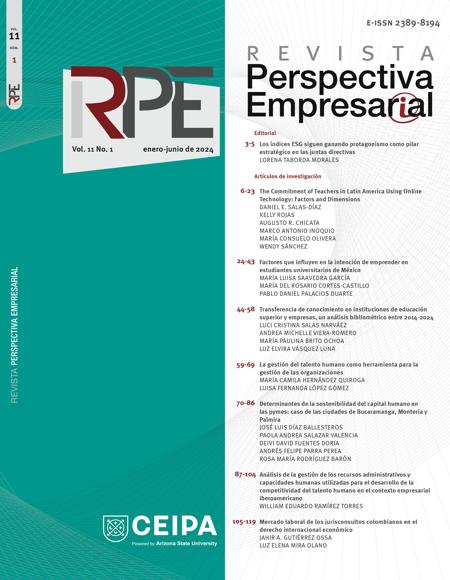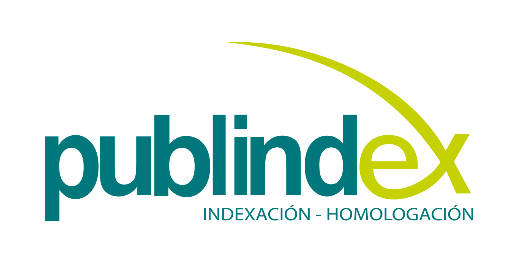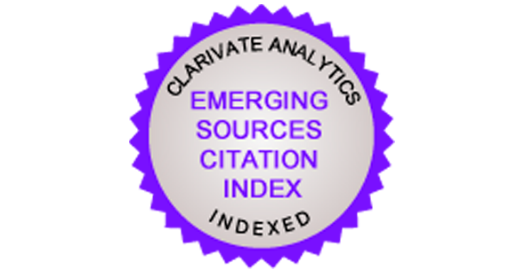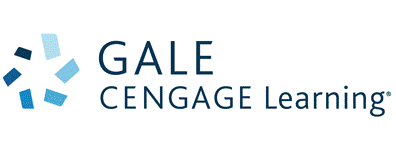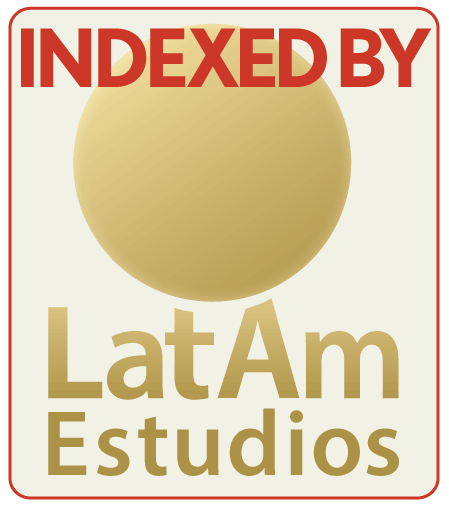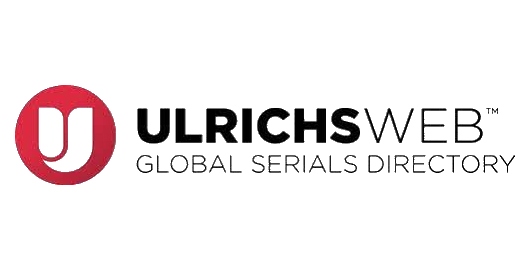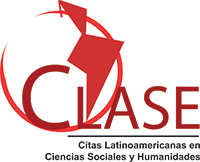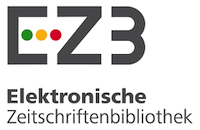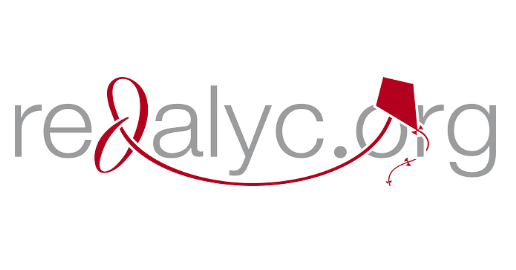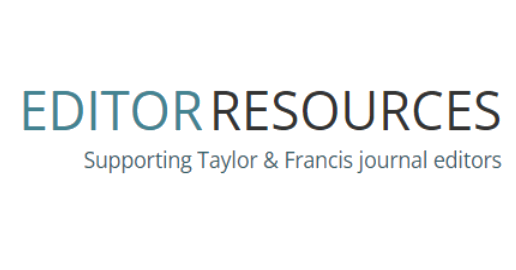Analysis of the management of administrative resources and human capabilities used to develop the competitiveness of human talent in the Ibero-American business context
Análisis de la gestión de los recursos administrativos y capacidades humanas utilizadas para el desarrollo de la competitividad del talento humano en el contexto empresarial iberoamericano
##plugins.themes.bootstrap3.article.main##
Objective. To identify, analyze, and interpret the key intangibles associated
with human capital as critical factors for contemporary business competitiveness through
a theoretical-practical exploration of resource-based theory. Methodology. The study
conducted a systematic review of scientific evidence, implementing the PRISMA method
with the Scopus database as the primary resource. Results. The findings were examined
using a qualitative approach encompassing both descriptive and hermeneutic perspectives.
The study reveals that business competitiveness is founded on the ability of organizations to
efficiently manage technical, technological, and financial resources. This involves enhancing
human skills to foster creativity, innovation and productivity, along with the ability to adapt to
changes and economic shifts in the markets. Conclusions. It is highlighted that competitive
advantages are achieved by strengthening employees’ intellectual capital through leadership
processes in knowledge, technical training, research, and human resource management.
Downloads
##plugins.themes.bootstrap3.article.details##
Abad, E. y Valls, M. (2018). Análisis estratégico de la banca ética en España a través de Triodos Bank. Financiación de proyectos sociales y medioambientales. CIRIECEspaña. Revista de Economía Pública, Social y Cooperativa, 92(9), 87-120. DOI: https://doi.org/10.7203/CIRIEC-E.92.10805
https://doi.org/10.7203/CIRIEC-E.92.10805 DOI: https://doi.org/10.7203/CIRIEC-E.92.10805
Alonso-Ubieta, S., Mora-Esquivel, R. and Leiva, J.C. (2021). The competitive efficiency of Costa Rican small and medium-sized businesses: a data envelopment analysis approach. Competitiveness Review: An International Business Journal, 31(3), 420-438. DOI: https://doi.org/10.1108/CR-12-2019-0142
https://doi.org/10.1108/CR-12-2019-0142 DOI: https://doi.org/10.1108/CR-12-2019-0142
Amit, R. and Schoemaker, P. (1993). Strategic Assets and Organizational Rent. Strategic Management Journal, 14(1), 33-46. DOI: https://doi.org/10.1002/smj.4250140105
https://doi.org/10.1002/smj.4250140105 DOI: https://doi.org/10.1002/smj.4250140105
Archambault, É. et al. (2006). Benchmarking scientific output in the social sciences and humanities: The limits of existing databases. Scientometrics, 68(3), 329-342. DOI: https://doi.org/10.1007/s11192-006-0115-z
https://doi.org/10.1007/s11192-006-0115-z DOI: https://doi.org/10.1007/s11192-006-0115-z
Avila-Toscano, J. et al. (2022). Determinantes de la producción de artículos científicos de ciencias sociales en Colombia incluidos en WoS-Scopus y otros índices: árbol de clasificación y regresión. Revista Interamericana de Bibliotecología, 45(1), e339712. DOI: https://doi.org/10.17533/udea.rib.v45n1e339712
https://doi.org/10.17533/udea.rib.v45n1e339712 DOI: https://doi.org/10.17533/udea.rib.v45n1e339712
Azegele, M., Okeyo, W. and Nyambegera, S. (2021). The mediating effect of human resource management practice on the relationship between corporate governance and organizational performance of insurance companies in Kenya. Journal of Human Resource and Leadership, 5(3), 89-103. DOI: https://doi.org/10.53819/81018102t20010
https://doi.org/10.53819/81018102t20010 DOI: https://doi.org/10.53819/81018102t20010
Beck, D. et al. (2023). Strategic resource management in private, public, and mixed-owned organisations in cities: the power of strategic urban networks. International Journal of Services, Economics and Management, 14(2), 198-223. DOI: https://doi.org/10.1504/IJSEM.2023.131134
https://doi.org/10.1504/IJSEM.2023.131134 DOI: https://doi.org/10.1504/IJSEM.2023.131134
Belso-Martinez, J.A., Molina-Morales, F.X. and MasVerdu, F. (2013). Combining effects of internal resources, entrepreneur characteristics and KIS on new firms. Journal of Business Research, 66(10), 2079-2089. DOI: https://doi.org/10.1016/j.jbusres.2013.02.034
https://doi.org/10.1016/j.jbusres.2013.02.034 DOI: https://doi.org/10.1016/j.jbusres.2013.02.034
Beltrán-Martín, I., Bou-Llusar, J.C. and Salvador-Gómez, A. (2021). HR flexibility and firm performance in professional service firms. Journal of Management & Organization, 2021, 1-22.
Caicedo-Valencia, V.M. y Acosta-Aguirre, A.M. (2012). La gestión del talento y el ser humano como sujeto de desarrollo. Revista Politécnica, 8(14), 105-113.
Calderón-Hernández, G., Vivares, J.A. y Naranjo, J.C. (2023). Gestión humana en Colombia: nivel de desarrollo de la función y de sus prácticas. Estudios Gerenciales, 39(166), 77-92. DOI: https://doi.org/10.18046/j.estger.2023.166.5521
https://doi.org/10.18046/j.estger.2023.166.5521 DOI: https://doi.org/10.18046/j.estger.2023.166.5521
Calicchio, A.C. e Marcondes, R.C. (2016). Fatores relevantes de competitividade no negócio de consultoria de tecnologia da informação. Gestão & Produção, 23(3), 625-637. DOI: https://doi.org/10.1590/0104-530x0403_15
https://doi.org/10.1590/0104-530x0403_15 DOI: https://doi.org/10.1590/0104-530x0403_15
Cardona, R. (2011). Estrategia basada en los recursos y capacidades criterios de evaluación y el proceso de desarrollo. Revista Electrónica FORUM Doctoral, 4, 113-147.
Chiappetta, C.J., Mauricio, A.L. and de Sousa, A.B.L. (2017). Critical success factors and green supply chain management proactivity: shedding light on the human aspects of this relationship based on cases from the Brazilian industry. Production Planning & Control, 28(6-8), 671-683. DOI: https://doi.org/10.1080/09537287.2017.1309705
https://doi.org/10.1080/09537287.2017.1309705 DOI: https://doi.org/10.1080/09537287.2017.1309705
Danvila-del-Valle, I., Estévez-Mendoza, C. and Lara, F.J. (2019). Human resources training: A bibliometric analysis. Journal of Business Research, 101, 627- 636. DOI: https://doi.org/10.1016/j.jbusres.2019.02.026
https://doi.org/10.1016/j.jbusres.2019.02.026 DOI: https://doi.org/10.1016/j.jbusres.2019.02.026
Deci, E.L. and Ryan, R.M. (2000). The "What" and "Why" of Goal Pursuits: Human Needs and the SelfDetermination of Behavior. Psychological Inquiry, 11(4), 227-268. DOI: https://doi.org/10.1207/S15327965PLI1104_01
https://doi.org/10.1207/S15327965PLI1104_01 DOI: https://doi.org/10.1207/S15327965PLI1104_01
Díaz-Fernández, M.C., González-Rodríguez, M.R. and Simonetti, B. (2015). Top management team's intellectual capital and firm performance. European Management Journal, 33(5), 322-331. DOI: https://doi.org/10.1016/j.emj.2015.03.004
https://doi.org/10.1016/j.emj.2015.03.004 DOI: https://doi.org/10.1016/j.emj.2015.03.004
Diez-Vial, I. and Fernández-Olmos, M. (2014). Moderating influence of internal resources on cluster externalities. EuroMed Journal of Business, 9(1), 75-92. DOI: https://doi.org/10.1108/EMJB-04-2013-0014
https://doi.org/10.1108/EMJB-04-2013-0014 DOI: https://doi.org/10.1108/EMJB-04-2013-0014
Eisenhardt, K. and Martin, J. (2000). Dynamic capabilities: ¿what are they? Strategic Management Journal, 21(10-11), 1105-1121. DOI: https://doi.org/10.1002/1097-0266(200010/11)21:10/11<1105::AID-SMJ133>3.0.CO;2-E
https://doi.org/10.1002/1097-0266(200010/11)21:10/11<1105::AID-SMJ133>3.0.CO;2-E DOI: https://doi.org/10.1002/1097-0266(200010/11)21:10/11<1105::AID-SMJ133>3.0.CO;2-E
Grant, R. (1996). Prospering in Dynamically Competitive Environments: Organizational Capability as Knowledge Integration. Organization Science, 7(4), 375-387. DOI: https://doi.org/10.1287/orsc.7.4.375
https://doi.org/10.1287/orsc.7.4.375 DOI: https://doi.org/10.1287/orsc.7.4.375
Huang, M.-H. and Lin, C.-S. (2011). A Citation Analysis of Western Journals Cited in Taiwan's Library and Information Science and History Research Journals: From a Research Evaluation Perspective. The Journal of Academic Librarianship, 37(1), 34- 45. DOI: https://doi.org/10.1016/j.acalib.2010.10.005
https://doi.org/10.1016/j.acalib.2010.10.005 DOI: https://doi.org/10.1016/j.acalib.2010.10.005
López, J. and Serrano, B. (2020). Human capital and export performance in the Spanish manufacturing firms. Baltic Journal of Management, 15(1), 99-119. DOI: https://doi.org/10.1108/BJM-04-2019-0143
https://doi.org/10.1108/BJM-04-2019-0143 DOI: https://doi.org/10.1108/BJM-04-2019-0143
Machorro, F. et al. (2016). Influencia del capital relacional en el desempeño organizacional de las instituciones de educación superior tecnológica. INNOVAR, 26(60), 35-50. DOI: https://doi.org/10.15446/innovar.v26n60.55531
https://doi.org/10.15446/innovar.v26n60.55531 DOI: https://doi.org/10.15446/innovar.v26n60.55531
Martín-Hidalgo, F.A. and Pérez-Luño, A. (2022). Uncovering hidden human capital in uncertain times by exploring strategic resources in Spanish wineries. International Journal of Wine Business Research, 34(1), 69-85. DOI: https://doi.org/10.1108/IJWBR-01-2021-0002
https://doi.org/10.1108/IJWBR-01-2021-0002 DOI: https://doi.org/10.1108/IJWBR-01-2021-0002
Núñez-Cacho, P., Grande, F.A. and Lorenzo, D. (2015). The effects of coaching in employees and organizational performance: The Spanish Case. Intangible Capital, 11(2), 166-189. DOI: https://doi.org/10.3926/ic.586
https://doi.org/10.3926/ic.586 DOI: https://doi.org/10.3926/ic.586
Osorio‐Londoño, A.A., Naranjo‐Valencia, J.C. and Calderón‐Hernández, G. (2020). Training and its influence on competitive strategy implementation. Human Resource Development Quarterly, 31(2), 149-172. DOI: https://doi.org/10.1002/hrdq.21381
https://doi.org/10.1002/hrdq.21381 DOI: https://doi.org/10.1002/hrdq.21381
Padilha, A.C. et al. (2017). The dynamics of strategy and resources of the jewelry sector in Brazil. Revista ESPACIOS, 38(12), 7-29.
Parra, C. y Toro, I. (2014). Revisión del concepto de desarrollo estratégico del recurso humano desde el análisis de la literatura. Suma de Negocios, 5(11), 108-116. DOI: https://doi.org/10.1016/S2215-910X(14)70025-4
https://doi.org/10.1016/S2215-910X(14)70025-4 DOI: https://doi.org/10.1016/S2215-910X(14)70025-4
Peñalver, A. (2021). El nuevo rol de recursos humanos en momentos de alta incertidumbre. Capital Humano, 365, 123-129.
Sánchez-Peñaflor, S. y Herrera-Aviles, M. (2016). Los recursos humanos bajo el enfoque de la teoría de los recursos y capacidades. Revista de la Facultad de Ciencias Económica: Investigación y Reflexión, 24(2), 133-146. DOI: https://doi.org/10.18359/rfce.2216
https://doi.org/10.18359/rfce.2216 DOI: https://doi.org/10.18359/rfce.2216
Seclen-Luna, J.P. et al. (2021). Assessing the effects of human capital composition, innovation portfolio and size on manufacturing firm performance. Competitiveness Review: An International Business Journal, 31(3), 625-644. DOI: https://doi.org/10.1108/CR-01-2020-0021
https://doi.org/10.1108/CR-01-2020-0021 DOI: https://doi.org/10.1108/CR-01-2020-0021
Sehnem, S. et al. (2016). Competitive advantage in a credit cooperative: the role of resources. International Business Management, 10(15), 2768- 2779.
Serrano, B.J. (2017). La influencia de los recursos de capital humano sobre el comportamiento exportador de las empresas manufactureras. Revista ESPACIOS, 38(18), 13-23.
Sierra, M.R. et al. (2017). Patrón de citas de la producción científica en Ciencias Sociales y Humanidades. Un análisis a partir de Scopus (2000-2012). Ciencias de la Información, 48(1), 37-44.
Tangthong, S., Trimetsoontorn, J. and Rojniruntikul, N. (2014). HRM practices and employee retention in Thailand. A literature review. International Journal of Trade, Economics and Finance, 5(2), 162-166. DOI: https://doi.org/10.7763/IJTEF.2014.V5.362
https://doi.org/10.7763/IJTEF.2014.V5.362 DOI: https://doi.org/10.7763/IJTEF.2014.V5.362
Teece, D. (1982). Towards an economic theory of the multiproduct firm. Journal of Economic Behavior & Organization, 3(1), 39-63. DOI: https://doi.org/10.1016/0167-2681(82)90003-8
https://doi.org/10.1016/0167-2681(82)90003-8 DOI: https://doi.org/10.1016/0167-2681(82)90003-8
Teece, D. and Pisano, G. (1994). The dynamic capabilities of firms: an introduction. Industrial and Corporate Change, 3(3), 537-556. DOI: https://doi.org/10.1093/icc/3.3.537-a
https://doi.org/10.1093/icc/3.3.537-a DOI: https://doi.org/10.1093/icc/3.3.537-a
Torres, L. y Díaz, J. (2010). Organizaciones basadas en inteligencia: aproximación a una realidad del siglo XXI. Revista Científica Teorías, Enfoques y Aplicaciones en las Ciencias Sociales, 3(5), 117-127.
Villegas, E.V., Hernández, M.A. y Salazar, B.C. (2017). La medición del capital intelectual y su impacto en el rendimiento financiero en empresas del sector industrial en México. Contaduría y Administración, 62(1), 184-206. DOI: https://doi.org/10.1016/j.cya.2016.10.002
https://doi.org/10.1016/j.cya.2016.10.002 DOI: https://doi.org/10.1016/j.cya.2016.10.002
Vivares, J.A., Sarache, W. y Naranjo, J.C. (2017). La gestión humana en la estrategia de manufactura: un estudio empírico en la industria caldense. Bogotá, Colombia: Editorial Universidad Nacional de Colombia.
Urrutia-Badillo, Y., Lopez-Cabrales, A. and Valle, R. (2018). A multidimensional approach to the content of human capital: Dimensions, emergence process and organizational capabilities. Management Research: The Journal of the Iberoamerican Academy of Management, 16(2), 138-158. DOI: https://doi.org/10.1108/MRJIAM-05-2016-0666
https://doi.org/10.1108/MRJIAM-05-2016-0666 DOI: https://doi.org/10.1108/MRJIAM-05-2016-0666
Wether, W., Davis, K. y Guzmán, P. (2019). Administración de capital humano. Ciudad de México, México: McGraw Hill.
Zarazúa, J.L. (2019). Administración de recursos humanos versus gestión del capital humano. Diferencias, coincidencias y contradicciones. Gestión y Estrategia, 56, 37-50. DOI: https://doi.org/10.24275/uam/azc/dcsh/gye/2019n56/Zarazua
https://doi.org/10.24275/uam/azc/dcsh/gye/2019n56/Zarazua DOI: https://doi.org/10.24275/uam/azc/dcsh/gye/2019n56/Zarazua
Zollo, M. and Winter, S. (2002). Deliberate Learning and the Evolution of Dynamic Capabilities. Organization Science, 13(3), 339-351. DOI: https://doi.org/10.1287/orsc.13.3.339.2780
https://doi.org/10.1287/orsc.13.3.339.2780 DOI: https://doi.org/10.1287/orsc.13.3.339.2780

